Paul Rand Antique MID Century Modern Abstract Oil Painting Old Vintage 1967 Rare
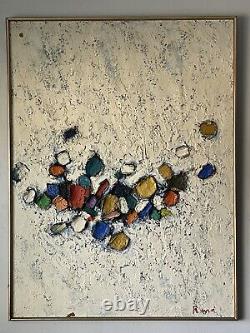
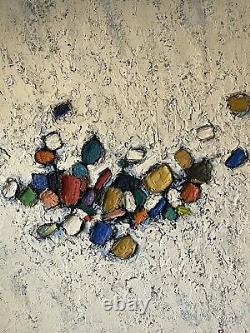
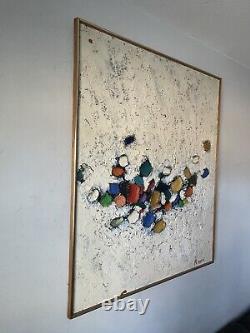
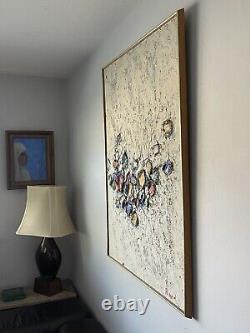
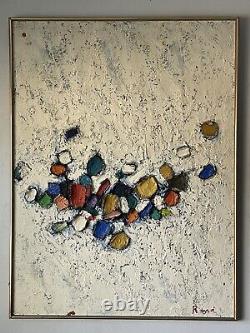
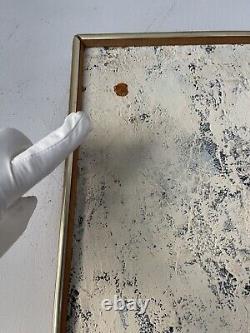

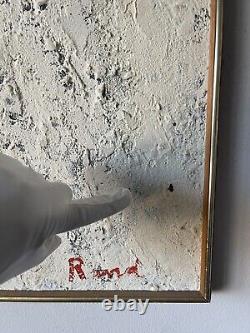
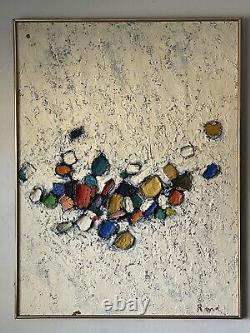
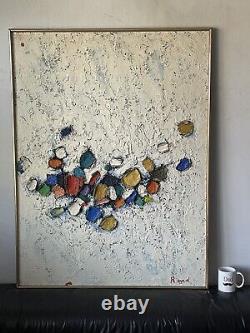
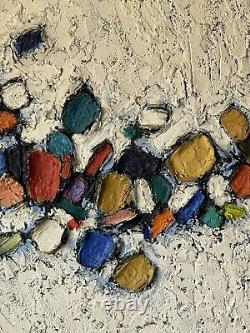
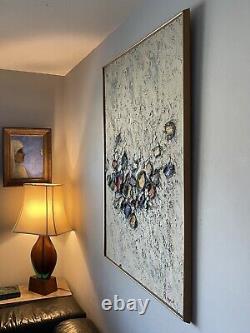
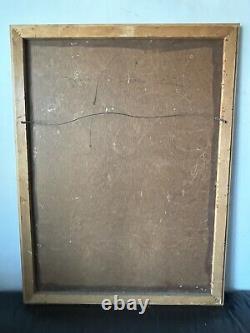
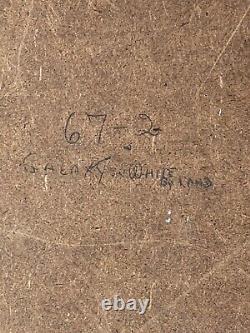
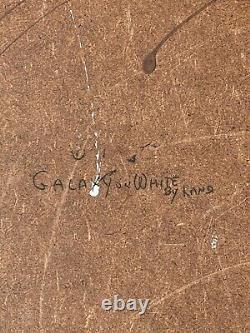
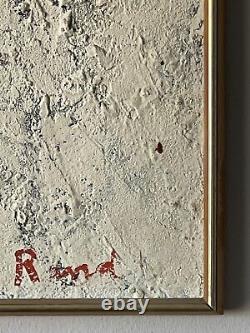


RARE AND OUTSTANDING ANTIQUE MID-CENTURY MODERN ABSTRACT OIL PAINTING ON BOARD BY REVERED ART DIRECTOR - ILLUSTRATOR, AND PAINTER PAUL RAND. THIS WORK DEPICTS A BEAUTIFUL THICK IMPASTO MODERNIST ABSTRACT COMPRISED OF MULTI-COLORED SHAPES PROTRUDING OFF A WHITE TEXTURED BACKGROUND. SIGNED BY RAND AND DATED 1967. THERE'S A SOME STAINS, AS HIGHLIGHTED IN THE PHOTOGRAPHS. IT DOES NOT DETRACT FROM ITS BEAUTY IN ANY WAY. DIMENSIONS: 37"W x 49"H. Born: 1914 - Brooklyn, New York City. Died: 1996 - Norwalk, Connecticut. Known for: Advertising art director, illustration, graphic design, logos, painter.
Everything Is Design: The Work of Paul Rand features more than 150 advertisements, posters, corporate brochures, and books by this master of American design. It was Rand who most creatively brought European avant-garde art movements such as Cubism and Constructivism to graphic design in the United States. Paul Rand (August 15, 1914 - November 26, 1996) was an American art director and graphic designer, best known for his corporate logo designs, including the logos for IBM, UPS, Enron, Morningstar, Inc. Westinghouse, ABC, and Steve Jobs's NeXT.
He was one of the first American commercial artists to embrace and practice the Swiss Style of graphic design. Rand was a professor emeritus of graphic design at Yale University in New Haven, Connecticut from 1956 to 1969, and from 1974 to 1985. He was inducted into the New York Art Directors Club Hall of Fame in 1972.
Paul Rand (Peretz Rosenbaum) was born on August 15, 1914 in Brooklyn, New York. He embraced design at a very young age, painting signs for his father's grocery store as well as for school events at P.
Rand's father did not believe art could provide his son with a sufficient livelihood, and so he required Paul to attend Manhattan's Harren High School while taking night classes at the Pratt Institute. Rand was largely "self-taught" as a designer, learning about the works of Cassandre and Moholy-Nagy from European magazines such as Gebrauchsgraphik. Rand also attended Parsons The New School for Design and the Art Students League of New York. His career began with humble assignments, starting with a part-time position creating stock images for a syndicate that supplied graphics to various newspapers and magazines.
Between his class assignments and his work, Rand was able to amass a fairly large portfolio, largely influenced by the German advertising style Sachplakat (object poster) as well as the works of Gustav Jensen. It was around this time that he decided to camouflage the overtly Jewish identity conveyed by his name, Peretz Rosenbaum, shortening his forename to'Paul' and taking'Rand' from an uncle to form a Madison Avenue-friendly surname. Morris Wyszogrod, a friend and associate of Rand, noted that he figured that'Paul Rand,' four letters here, four letters there, would create a nice symbol. So he became Paul Rand.
Behrens notes the importance of this new title: Rand's new persona, which served as the brand name for his many accomplishments, was the first corporate identity he created, and it may also eventually prove to be the most enduring. Indeed, Rand was rapidly moving into the forefront of his profession. Among the accolades Rand received were those of László Moholy-Nagy: Among these young Americans, it seems to be that Paul Rand is one of the best and most capable.
He is a painter, lecturer, industrial designer, [and] advertising artist who draws his knowledge and creativeness from the resources of this country. He is an idealist and a realist, using the language of the poet and business man. He thinks in terms of need and function. He is able to analyze his problems but his fantasy is boundless. The reputation Rand so rapidly amassed in his prodigious twenties never dissipated; rather, it only managed to increase through the years as his influential works and writings firmly established him as the éminence grise of his profession.Although Rand was most famous for the corporate logos he created in the 1950s and 1960s, his early work in page design was the initial source of his reputation. In 1936, Rand was given the job of setting the page layout for an Apparel Arts (now GQ) magazine anniversary issue. His remarkable talent for transforming mundane photographs into dynamic compositions, which. Gave editorial weight to the page earned Rand a full-time job, as well as an offer to take over as art director for the Esquire-Coronet magazines. Initially, Rand refused this offer, claiming that he was not yet at the level the job required, but a year later he decided to go ahead with it, taking over responsibility for Esquire's fashion pages at the young age of twenty-three.
The cover art for Direction magazine proved to be an important step in the development of the "Paul Rand look" that was not as yet fully developed. The December 1940 cover, which uses barbed wire to present the magazine as both a war-torn gift and a crucifix, is indicative of the artistic freedom Rand enjoyed at Direction.
Rand's most widely known contributions to design are his corporate identities, many of which are still in use. IBM, ABC, Cummins Engine, UPS, and the now-infamous Enron, among many others, owe Rand their graphical heritage. One of his strengths, as Moholy-Nagy pointed out, was his ability as a salesman to explain the needs his identities would address for the corporation. According to graphic designer Louis Danziger: He almost singlehandedly convinced business that design was an effective tool.Anyone designing in the 1950s and 1960s owed much to Rand, who largely made it possible for us to work. He more than anyone else made the profession reputable. We went from being commercial artists to being graphic designers largely on his merits. The most notable of his later works was his collaboration with Steve Jobs for the NeXT Computer corporate identity; Rand's simple black box breaks the company name into two lines, producing a visual harmony that endeared the logogram to Jobs.
Steve Jobs was pleased: just prior to Rand's death in 1996, his former client labeled him the greatest living graphic designer. Rand devoted his final years to design work and the writing of his memoirs.In 1996, he died of cancer at age 82 in Norwalk, Connecticut. He is buried in Beth El Cemetery.
Though Rand was a recluse in his creative process, doing the vast majority of the design load despite having a large staff at varying points in his career, he was very interested in producing books of theory to illuminate his philosophies. László Moholy-Nagy may have incited Rand's zeal for knowledge when he asked his colleague if he read art criticism at their first meeting. Rand said no, prompting Moholy-Nagy to reply Pity.
During Rand's later career, he became increasingly agitated about the rise of postmodernist theory and aesthetic in design. In 1992, Rand resigned his position at Yale in protest of the appointment of postmodern and feminist designer Sheila Levrant de Bretteville, and convinced his colleague, Armin Hofmann to do the same. In justification of his resignation, Rand penned the article "Confusion and Chaos: The Seduction of Contemporary Graphic Design, " in which he denounced the postmodern movement as "faddish and frivolous" and harbor[ing] its own built-in boredom.
Regardless of this dispute, Rand's contribution to modern graphic design theory in total is widely considered intrinsic to the profession's development. The core ideology that drove Rand's career, and hence his lasting influence, was the modernist philosophy he so revered. He celebrated the works of artists from Paul Cézanne to Jan Tschichold, and constantly attempted to draw the connections between their creative output and significant applications in graphic design. In A Designer's Art Rand clearly demonstrates his appreciation for the underlying connections: From Impressionism to Pop Art, the commonplace and even the comic strip have become ingredients for the artist's cauldron.
What Cézanne did with apples, Picasso with guitars, Léger with machines, Schwitters with rubbish, and Duchamp with urinals makes it clear that revelation does not depend upon grandiose concepts. The problem of the artist is to defamiliarize the ordinary. Museum of Art Norman, OK.This item is in the category "Art\Paintings". The seller is "vintagerotty" and is located in this country: US. This item can be shipped to United States.
- Artist: Paul Rand
- Unit of Sale: Single Piece
- Signed By: Rand
- Size: Large
- Signed: Yes
- Title: Galaxy On White
- Material: Oil On Board
- Item Length: 37”
- Region of Origin: New York, USA
- Framing: Framed
- Subject: Art, Modern
- Type: Painting
- Year of Production: 1967
- Original/Licensed Reproduction: Original
- Item Height: 49”
- Style: Abstract, Modernism
- Features: One of a Kind (OOAK)
- Production Technique: Oil Painting
- Country/Region of Manufacture: United States
- Culture: Expressionist Modernism
- Handmade: Yes
- Item Width: 37”
- Time Period Produced: 1960-1969


